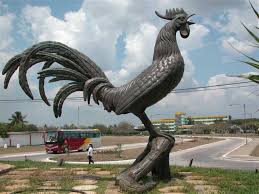
“In Cuba the rooster of Morón is a sculpture of bronze of three meters and Three tons, while in Spain there are two, but smaller.
To Morón de la Frontera, Spain, a good day arrived from the distant sixteenth century, a public official with the purpose of calming the heated mood, derived from political rivalries for the appointment of the municipal authorities in that place of the Spanish geography, located in the community Autonomous region of Andalusia, in the province of Seville
He said loudly, defiantly, “There is no more rooster here than I am,” and they say that soon afterwards a group of strangers covered by the darkness of the night undressed and gave a sovereign beating of the irrespectous guapetón, immortalized in a verse That says like this: “Going that you are staying / like the rooster of Morón / without feathers and cacareando / in the best occasion”.
In 1543 the Spanish settlers founded in the central Cuban province of Ciego de Avila the village of Morón, where the friendly copla came, but it was not until the mid-1950s, thanks to the initiative of Dr. Benito Llanes Recino, Which was erected a monument to the rooster, inaugurated by Fulgencio Batista.
At the triumph of the Revolution of Fidel Castro, on January 1, 1959, the effigy of the plumífero was torn off, first of its pedestal and finally destroyed, to believe it representative of the deposed regime, in acts of inculturation that motivated angry protests of the moronenses, Injured by the outrage to the symbol of the city.
The acts of vandalism occurred in February 1960 and 22 years later the hand of the artists Rita Longa and Armando Alonso, returned the rooster to the locals, sculpted in bronze and located at the entrance of the municipality, adjacent to the tower of A clock, that every six hours shows the hour and emits in three occasions the song of the bird.
For the citizens of the Spanish Moron de la Frontera and the Moron of the Caribbean island of Cuba, the cock is a local emblem and almost by carambola has double nationality, with the difference that in the place of origin, the statue is with the calamos al aire And in his adopted crib he appears erect and with all his gleaming feathers.
Desde España hasta Camagüey, Cuba históricamente ” Quedó como el Gallo de Morón!”.

En Cuba el gallo de Morón es una escultura de bronce de tres metros y tres toneladas, mientras en España hay dos, pero más pequeñas.
A Morón de la Frontera, llegó un buen día del lejano siglo XVI, un funcionario público con el propósito de calmar los caldeados ánimo, derivados de rivalidades políticas por el nombramiento de las autoridades municipales en ese paraje de la geografía española, ubicado en la comunidad autónoma de Andalucía, en la provincia de Sevilla
Aquel señor proclamó a viva voz en tono desafiante “Aquí no hay más gallo que yo” y cuentan que poco después un grupo de desconocidos amparados por la oscuridad de la noche desnudaron y propinaron una soberana paliza de escarmiento al irrespetuoso guapetón, inmortalizado en un verso que dice así: “Anda que te vas quedando/ como el gallo de Morón/ sin plumas y cacareando/ en la mejor ocasión’.
En 1543 los colonizadores españoles fundaron en la central provincia cubana de Ciego de Avila la villa de Morón, donde llegó la simpática copla, pero no fue hasta mediados de la década del 50 del siglo XX, gracias a la iniciativa del doctor Benito Llanes Recino, que se erigió un monumento al gallo, inaugurado por Fulgencio Batista.
Al triunfo de la Revolución de Fidel Castro, el primero de enero de 1959, la efigie del plumífero resultó arrancada, primero de su pedestal y finalmente destruida, por creerla representativa del depuesto régimen, en actos de incultura que motivaron airadas protestas de los moronenses, heridos por el ultraje al símbolo de la ciudad.
Los hechos de vandalismo ocurrieron en febrero de 1960 y 22 años más tarde la mano de los artista Rita Longa y Armando Alonso, devolvió el gallo a los moradores del lugar, esculpido en bronce y situado a la entrada del municipio, contiguo a la torre de un reloj, que cada seis horas muestra la hora y emite en tres ocasiones el canto del ave.
Para los ciudadanos del Morón de la Frontera español y el Morón de la isla caribeña de Cuba, el gallo es emblema local y casi por carambola posee doble nacionalidad, con la diferencia que en el sitio de origen, la estatua está con los cálamos al aíre y en su cuna adoptiva aparece erguido y con todas sus relucientes plumas.
Agencies/Arrajatabla/Alberto Denis/Internet Photos/ Arnoldo Varona/ TheCubanHistory.com
THE CUBAN HISTORY, HOLLYWOOD.






